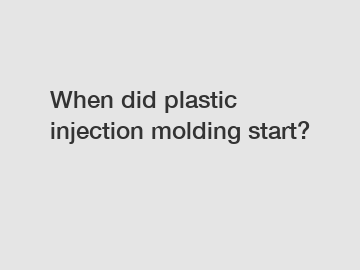When did plastic injection molding start?
Have you ever wondered when plastic injection molding first started? It’s a process that has revolutionized manufacturing and production as we know it. Let’s take a closer look at the history of plastic injection molding and how it all began.
Plastic injection molding: A brief overview.
Plastic injection molding is a manufacturing process that involves injecting molten plastic into a mold cavity to create a desired shape. This process is widely used in the production of various products, from toys and household items to automotive parts and medical devices. It allows for the mass production of high-quality, precise parts at a relatively low cost.

1. The birth of plastic injection molding.
Plastic injection molding first emerged in the late 19th century, with the invention of the first injection molding machine in 1872 by John Wesley Hyatt. Hyatt’s machine used a plunger to inject celluloid, a type of plastic, into a mold cavity. This revolutionary process paved the way for the mass production of plastic products and transformed the manufacturing industry.
2. The rise of synthetic plastics.
In the early 20th century, the development of synthetic plastics further fueled the growth of plastic injection molding. Companies began to experiment with new materials, such as Bakelite and nylon, which offered greater flexibility and durability compared to celluloid. These advancements made it possible to produce a wider range of products using injection molding techniques.
3. The post-war boom.
Plastic injection molding experienced a boom during the post-war period, when demand for consumer goods skyrocketed. Manufacturers embraced injection molding as a cost-effective and efficient way to produce large quantities of products, leading to the establishment of specialized molding companies and suppliers. This marked the beginning of the modern plastic injection molding industry as we know it today.
4. Continuous innovation.
Since its inception, plastic injection molding has undergone various advancements and innovations to improve efficiency, accuracy, and speed. Today, injection molding machines are equipped with state-of-the-art technologies, such as computer-aided design (CAD) and computer numerical control (CNC), to produce complex parts with high precision. This continuous innovation has made plastic injection molding one of the most widely used manufacturing processes across industries.
In conclusion, plastic injection molding has a rich history that dates back to the late 19th century. It has evolved from a rudimentary process using celluloid to a sophisticated manufacturing technique that produces high-quality plastic parts at scale. The role of suppliers in the plastic injection molding industry is crucial, providing companies with the tools and expertise they need to bring their product ideas to life. If you are in need of a reliable supplier for your injection molding project, don't hesitate to contact us to learn more about our services.
So, the next time you pick up a plastic product, remember the long journey that plastic injection molding has taken to make it possible. It’s a testament to human ingenuity and innovation.
Are you interested in learning more about Plastic Cnc Machining, High Polymer Polyethylene Guide, china pp sheet? Contact us today to secure an expert consultation!



